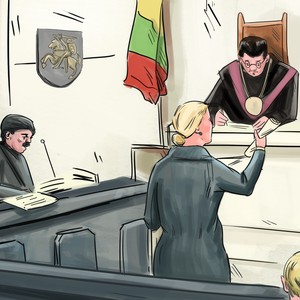 In commemoration of the International Right to Know Day – a step towards the openness of courts
In commemoration of the International Right to Know Day – a step towards the openness of courts
The local court of Raseiniai and the regional court of Kaunas have the highest workload in comparison with their respective courts of the same type, whereas the local court of Ignalina and the regional court of Klaipėda performed with the lowest ratings. The later are the findings of Transparency International Lithuania’s a novel initiative called ‘Open Courts’ (www.AtvirasTeismas.lt) which was created in collaboration with the National Court’s Administration of Lithuania.
The site displays the catalogs of open data collected by the National Courts Administration of Lithuania (http://www.teismai.lt/en/). This cooperation marks one of the first instances in the country of a nation-wide public sector institution opening up its database to a civil society entity.
“AtvirasTeismas.lt” enables the community at large to have a better understanding of the judiciary institutions in Lithuania and to better understand the criterions by which the work of a court or a judge can be measured. The criterions by which the platform allows to view, filter and compare the courts and judges are: the number of cases solved, average time to solve a case, judges’ experience, the courts annual budget and many more. This platform is one of the first of its kind worldwide.
In 2014, the local courts performed best when it comes to the average time per case ratio, solving one case in these type of courts took just above one months (1,39 months). Last year a single local court on average solved 7780 cases. It was also the workplace of the least experienced judges in the country averaging 12 years of duty service as a judge.
One step higher up the hierarchy of instances of courts and the average time to solve a case multiplies almost threefold – it takes around 4 months in the regional courts of Lithuania. That added up to 6909 cases during 2014. Next to that, on average the judges are more experienced in the regional courts with 18.6 years on court duty.
“I encourage all the public sector representatives to follow in the footsteps of the courts in opening up as much data as possible, thus enabling the society to learn more about how they operate. It would indeed contribute towards the goal of more trust in the public sector and would initiate a discussion about how to measure their effectiveness”, said Transparency International Lithuanian Chapter’s director Sergejus Muravjovas.
According to the director of National Courts’ Administration Reda Molienė, “AtvirasTeismas.lt” is another initiative that the courts congratulate as it only furthers their aim to present their work in a simple and easily-comprehensible manner. “It has been quite a while since all the court rulings, hearing schedules, judges’ biographies and other type of information is available publicly and can be reached at any given moment. “AtvirasTeismas.lt” is yet one more instrument by which the wider society will discover what do courts and judges work on day-to-day and how to they perform”, said Reda Molienė.
“AtvirasTeismas.lt” demonstrates that during 2014 a single judge on average solved around 600 cases. The average experience of a judge is 15 years, whereas the most experienced judges – averaging 22.8 years – hold office in the Court of Appeal of Lithuania. It costs almost 1 million euros (994 754) per year to support a single court.
The platform itself is created in cooperation with the National Courts’ Administration of Lithuania, which regularly collects the data about their work straight from the courts. Currently the website presents the data of the years 2009 – 2014.
The work of courts and judges in Lithuania from up-close can be found at www.AtvirasTeismas.lt
***
At this point the website itself is available only in Lithuanian but here is a quick run-through the filters where each colour represents a certain criterion:
Courts mode: green – cases solved; yellow – average time to solve a case; red – workload; blue – annual budget; purple – average years of experience in office per judge within a court.
Judges mode: green – cases solved; yellow – average time to solve a case; red – workload; cherry – days on duty per year; light green – years of experience in office serving as a judge.



